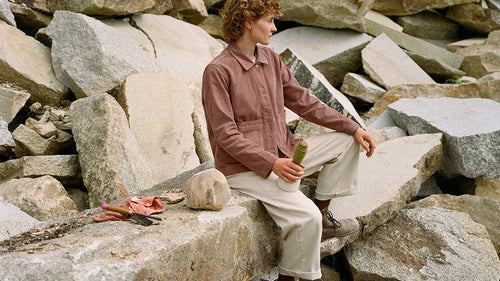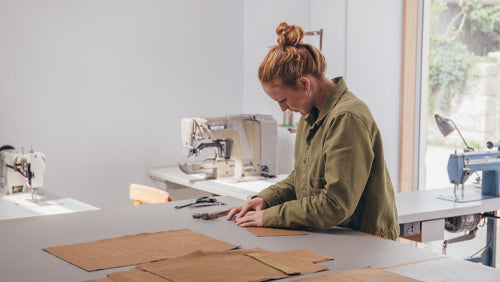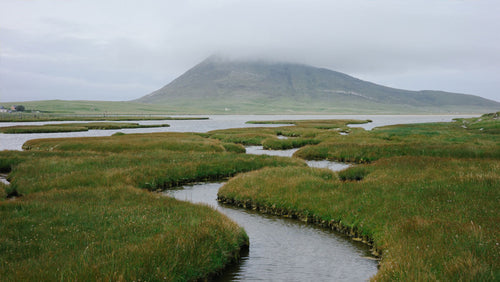Illustrations by Hannah Cousins.

If you've been here a while you'll know the name Jim Marsden.
He's been our photographer for every photoshoot since Batch No.2.
Back in 2017, I was lucky enough to attend one of Jim's one-day photography workshops in the Lake District in the North of England.
Before the group headed off on our photography walk, Jim handed out a small pack of cards to everyone.
On one side was a beautiful linocut illustration by Hannah Cousins, and on the other, one of Jim's photography principles. There were eight in total.
They were beautiful and very useful.
The advice he gave on the cards wasn't about photography hacks or specific techniques, but a way of being, learning and working. They're short timeless principles that help you to become a better photographer.
Over the years I've revisited the cards and re-read them again and again.
They're great reminders.
Last week when I was looking over them once more, but this time I asked Jim if I could share them with our community.
Lucky for all of us, he gave us the green light.
Here are the eight photography principles Jim shared with us on that walk back in 2017.
...
- 1 -

SIMPLE IS GOOD.
"Simplicity is the ultimate sophistication."
- Leonardo da Vinci
Don't let the technical aspects of photography become a barrier to your work.
These things can be learnt later and there are countless instructional videos online that delve deep (sometimes too deep) into the various tools available on digital cameras nowdays.
But all that knowledge of F-stops, shutter speeds, AF points and the myriad of different things available now, can be a lot to digest when you're starting.
Instead, try using simple equipment and see what you can achieve.
...
- 2 -

FILL YOUR LIBRARY.
"Without libraries what do we have?
We have no past and no future."
- Ray Bradbury
In your mind is a library, and it is unique.
It is different from every one of the other seven and a half billion human beings on this planet.
From this unique library, you will pull inspiration to make your work, and it's your responsibility to look after it and keep it replenished.
So, read widely from poetry to fiction to biography.
Listen to music, try different types and styles (it's never been easier).
Be aware of your experiences in life, both the good and bad (you need both).
Fill your library every day, because this is the fuel for your work.
...
- 3 -

EMULATE TO ASSIMMILATE.
"If you have seen further,
it is by standing on the shoulders of giants."
- Isaac Newton
There are many, many wonderful and amazing photographers that have gone before you. They are your teachers.
Learn from them by emulating them. Shoot like they shoot to understand why you like the images they produce, and figure out how they were created.
Painters, and writers, artists from all backgrounds were encouraged to learn this way.
The giants are all there waiting to help you. All you have to do is stand on their shoulders to see how they see.
...
- 4 -

LOOK FOR THE SHADOWS. THEY WILL LEAD YOU TO THE LIGHT.
"Were it not for shadows, there would be no beauty."
- Funchiro Tanizaki
Light, and your recognition of it, is one of the simplest and most important tools.
Be aware of the strength of it.
Be aware of the direction of it.
Be aware of the colour of it.
Be aware of where the shadows are, they will tell you the direction and strength of the light.
Spend time trying different metering (light / dark / mid etc) to appreciate how different light works.
...
- 5 -

DON'T WORRY ABOUT NEW. JUST BE YOU.
"Photography is an art of observation. It's about finding something interesting in an ordinary place... I've found it has little to do with the things you see and everything to do with the way you see them."
- Elliot Erwitt
The world is full of photographers. Many of them look at each other and borrow ideas and styles, trying to be 'new' or 'different'.
Instead of looking outward, look inward. The source of any uniqueness is already inside you.
So, dig deep. Realise the things that have shaped you and the way you think.
Let everything you find show itself in your work.
...
- 6 -

THINK LESS. FEEL MORE.
"The truth of a thing is the feel of a thing, not the think of it."
- Stanley Kubrick
If you are trying to produce your work with your own unique view, you have to start making the work that feels right to you. Other people might not like this work, but does it move you? Does it make you feel something? Then, it's probably the work you should be doing.
Be an immovable centre. Breathe. Allow the world to move around you. Feel it and respond to it.
Trust in your ability to observe.
Make your work a response to the way it makes you feel.
...
- 7 -

KNOW YOURSELF.
"He who knows others is wise;
he who knows himself is enlightened."
- Lao Tzu
You have a responsibility to make the work you were meant to. And if you're going to make your work, you have to know who you are.
Knowing who you are can be a lifetime's work.
You have to think deep.
Realise what you love, what you hate, think back to your childhood, recall both the good and the bad. Recall things that have stuck with you and look at these things again.
Make a little time to write every day. Put down on paper your thoughts, ideas and observations. Over time you'll start to be more aware of who you are.
...
- 8 -

SHOOT. REVIEW. LEARN. REPEAT.
"There is nothing noble in being superior to your fellow man; true nobility is being superior to your former self."
- Ernest Hemingway
You have to produce a lot of work to know what you like and the type of style of photographs you want to produce.
Each time you shoot, find a single (or more) image that you can say 'I like that'. Then ask yourself why. It took me a long time, and a lot of photographs, to figure out certain elements that I carry forward now.
Carry what you've learned from these few and put in your 'library'. You'll use these as part of your reference.
Repeat constantly. The more images you shoot, the more you review, the more you ask 'why', the closer you will get to who you visually are.
Be your own editor. Listen to yourself about your work. Answer your own questions.
...
You can see more of Jim's work on his website and on his Instagram.
Further reading recommended by Jim:
'Ways of Seeing' by John Berger (Penguin Modern Classic)
'The Photographer's Eye' by John Szarkowski
'The Nature of Photographs: A Primer' by Stephen Shore
'The Ongoing Moment: A Book About Photographs' by Geoff Dyer
'Henri Cartier-Bresson: Interviews and Conversations, 1951-1998' by Henri Cartier-Bresson
'On Being a Photographer: A Practical Guide' by David Hurn, Bill Jay
'Mirrors and Windows: American Photography since 1960' by John Szarkowski
...



